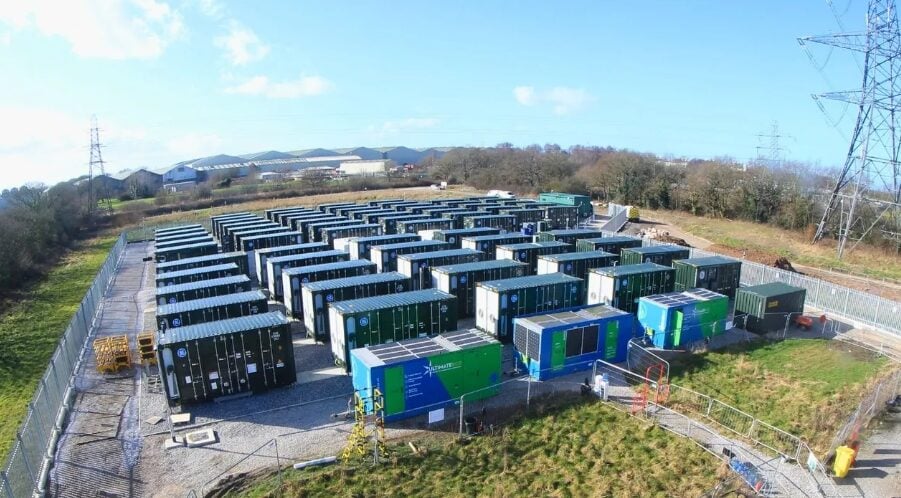
BESS asset management in the UK has moved beyond the rudimentary ‘project delivery and basic O&M’ approach, according to a speaker at the upcoming Battery Asset Management Summit UK & Ireland.
James Mills, managing director of energy storage investor Adaptogen Capital, gave a Q&A to Energy-Storage.news ahead of the two-day event taking place next week in London, 14-15 October 2025. He will be speaking on the ‘Skip Rates, Untapped Revenues & Removing the Cap; Growth of Analytics’ panel discussion on Day One.
Via its vehicle Varco Energy, Adaptogen is targeting 350MW of UK battery energy storage system (BESS) assets in operation by 2027, including a 100MW project recently acquired. It has two operational projects, the Native River BESS and the Sizing John BESS, each with 57MW/138MWh capacity and 2.4-hour duration.
Mills was one of the signatories to an open letter opposing the UK government’s long-duration energy storage (LDES) cap and floor scheme earlier this year.
Try Premium for just $1
- Full premium access for the first month at only $1
- Converts to an annual rate after 30 days unless cancelled
- Cancel anytime during the trial period
Premium Benefits
- Expert industry analysis and interviews
- Digital access to PV Tech Power journal
- Exclusive event discounts
Or get the full Premium subscription right away
Or continue reading this article for free
Energy-Storage.news: How has BESS asset management best practice in the UK/Ireland evolved in the past three years?
James Mills: Over the last three years BESS asset management has been transitioning from a “project delivery + basic O&M” to a much more disciplined, systems-level approach emphasising: (1) safety and emergency response, (2) formal asset-management systems and lifecycle planning, (3) market / operational maturity, encompassing complex revenue stacking, grid-code changes, (4) digital O&M including data, degradation modelling and real-time optimisation, and (5) clearer network connection/technical standards.
These shifts are driven by rapid deployment, tougher regulatory oversight, and commercial pressures to maximise lifetime value.
What is your current approach to maximising returns from your BESS, and what key performance indicators drive your operational decisions?
Our approach to maximising returns from our BESS portfolio is built around three pillars: commercial optimisation, asset integrity, and operational excellence.
In terms of commercial optimisation, we design our projects to offer the maximum cycling and duration flexibility, with current 2.5-hour durations and highly flexible performance warranties.
In asset integrity, protecting cell health and warranty value is as important as chasing marginal revenue. For operational excellence, we are implementing asset-management processes to drive reliability, availability, and safety.
Predictive analytics, condition-based maintenance, and robust incident-response frameworks keep uptime consistently above target, and cyber-secure remote monitoring reduces intervention times and costs.
How do you balance profitable market participation with preserving battery cell health, and what role do optimisation technologies play in this decision-making process?
We manage cell life within the constraints of our performance guarantees and use a range of technologies to help with the constant optimisation between financial returns and asset life.
How do you view the current state of risk-sharing between parties in the UK/Ireland BESS industry, and how will this evolve over time?
The UK market has moved from a contracted to merchant market model which had caused financing challenges. Given the huge financing need required to build 25GW by 2030, the growth in structured offtake contracts and new contracted services will be essential to underpin the next investment cycle. The Irish market remains challenging with its reliance on regulated frequency services and the slow evolution of power arbitrage markets, and connections.
What role do you see the LDES cap and floor scheme playing in the UK BESS industry in the long-term?
We believe it is needed to underpin the economic model of longer duration storage assets, but raises difficult questions about the degree to which it crowds out more market based and shorter duration storage solutions in the 2030s. We think a broad range of technology solutions is sensible for the UK’s LDES needs, and see BESS as having a key role to play due to their competitive cost, speed of execution and financeable status.
What is your strategy around end-of-life considerations when managing BESS assets?
We aim to maximise asset life through life extension continued use of depreciated cells where possible. We work closely with our BESS system providers to ensure a safe and responsible recycled solution is implemented at end of life.
